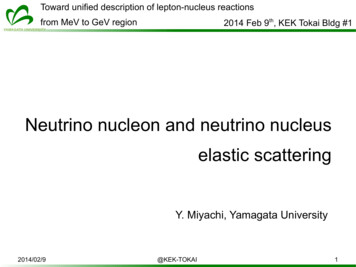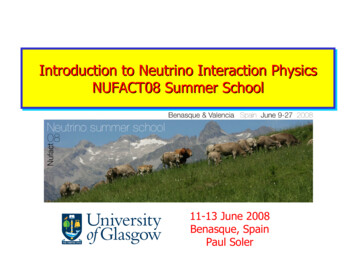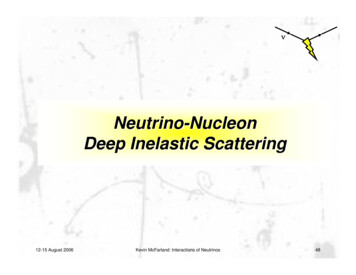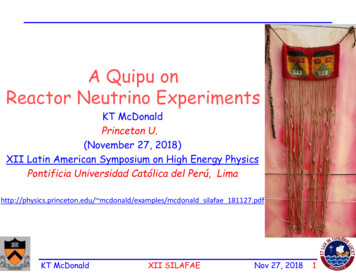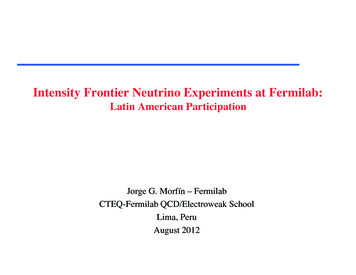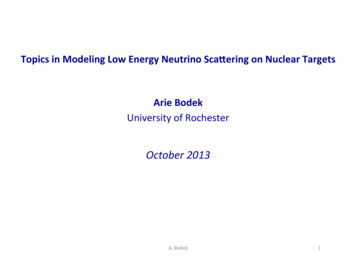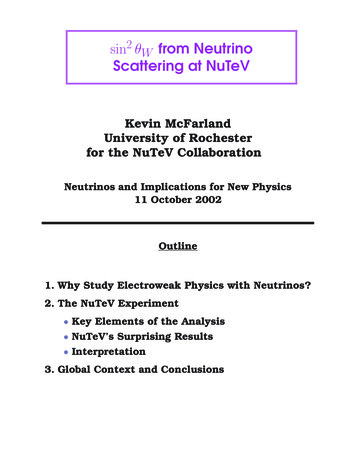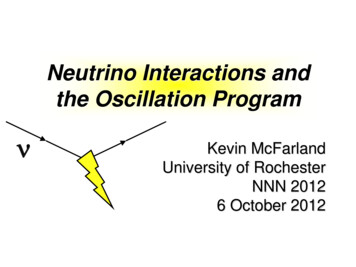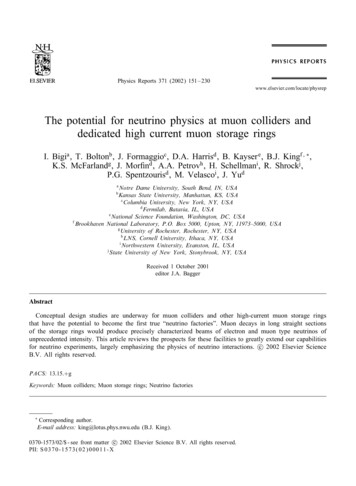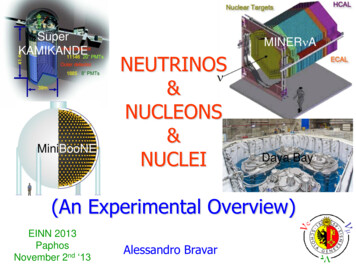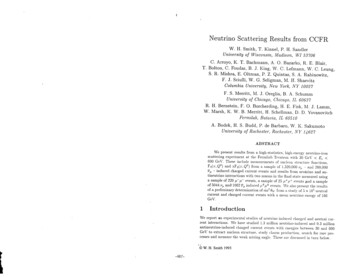
Transcription
NeutrinoScatteringW. H. Smith,UniversityC. Arroyo,T. Bolton,K. T. Bachmann,E. Oltman,ColumbiaW.UniversityR. H. Bernstein,G. Seligman,NewM. J. Oreglia,of Chicago,H. S. Budd,UniversityYork,NYC. Leung,10027B. A. SchummIL 6063YH. E. Fisk,Batavia,W.S. A. Rabinowitz,H. Schellman,M. J. Lamm,D. D. YovanovitchIL 60510P. de Barbaro,of Rochester,R. E. Blair,M. H. ShaevitzChicago,F. O. Borcherding,Fermilab,WI 53706W. C. Lefmann,P. Z. Quintas,K. W. B. Merritt,A. Bodek,P. H. SandierA. O. Bazarko,University,F. S. Merritt,from CCFRMadison,B. J. King,F. J. Sciulli,Marsh,T. Kinnel,of Wisconsin,C. Foudas,S. R. Mishra,W.ResultsRochester,W.K. SakumotoNYl 62YABSTRACTWe present results from a high-statistics, higll-eucrgy ueutriuo-irouscattering experiment at the Fermilal] Tevatron with 30 Gel’ E“ 600 GeV. These iuclucle measurements of Iluclcon structure functions,Fz(z, Q2) and xF3(. , Q*) from a sample of 1,320,000 v,, and 280,000VP – iuduced charged current, events ancl results from ncutriao and autineutriuo interactions with two muons in the final state measured usinga sample of 220 p– l– eveuts, a sample of 25 L L e :ents pncl a sampleof 5044 VI,and! 1062 PP inclucecl { *events. \\re also present the resultsof a preliminary determination of sin 011 from a study of 5 x 105 neutralcurrent and charged cclrrent events vith a mean neutrino energy of 166GeV.1IntroductionWe report on experimental studies of neutrino induced charged and neutral current interactions. lVe have studied 1.3 million llelltrillo-illclllcecl ancl 0.3 millionantineutrino-inducedchargecl current e ,euts with cucrgies I etween 30 aud 600GeV to extract UUCICOUstructure, study (harm production) search for rare processes and measure the ’eal:mixing angle. These t re discussed in turn I]elow.II0-4a7-W. H. Smith 1993
1.1StructureFunctionsNeutrino scattering provides a unique technique for measuring both the F2 andXF3 structure functions which are associated, in the quark parton nodel, withthe total quark (q Z) and valence quark (q - ) momentum, respectively. Thepredicted Q2 evolution of XF3 is particularly simple since it is not coupled to theunknown gluon distribution ancl, therefore, can be used .as a unambiguous testof perturbative Quantum Chromodynamics and measurement of Am. Combinedanalyses of F2 and XF3 allow the separation of the gluon evolu ion component andlead to information on the gluon structure function.1.2 DimudnsWe next report on chargecl current iutrract ions with two n]n )ns of the same andopposite electrlc charge m the final state. Events \vith two leptons of the samecharge are expected to be mostly due to pion an(l I aoll dectty in the hadronshowers of chargecl current events. Since the expect cd rat(’ with respect to chargedcurrent events is less than one in 10,000 (,ventsi salue sign dimuous offer theopportmlity to test for the presence of new physics. Opposite sign events resaltfrom reactions that produce a charmed qllark, followed by the leptonic decay of thecharmed part icle. Since charmed quarks are predominantly procluced hy valencedown quarks and sea strange qllarlis, a mrasurcment of the strangr content of thenucleon can be extracted from the prodactiou rate and Iiiuematics of the Oppositesign dirnuon events. The strange quark structnre flluction presented here is ofparticular theoretical interest in the exploration Iligh( r of order mass co rections[I], while the threshold behavior associ:tted with the heavy charm mass is criticalto the extraction of the weak mixing au l[,, sillz d,, frolll tlelltrillo ncntra] currcutdata.1.3WeakMixingAngleFinally, we report a new measurement of siu 8{1. Th(, Standard Llodel of Elcctrowe k Physics recluires as input five pa allletrrs to describe high-energy processes: a, GF, kfz, mt, and nr,,, The latter two enter into low-energy calcllliit iol)s,such as extracting sin2 Olv from vATscatt,criug, via loop corrections to the andZ self-energies. The radiative corrcctious to the (ff(ctiv( sillz 011’s measl!rcd indifferent interactions arc qaadratic in )It( for sltfi(itlltiy iarg( top lnass, but onlylogarithmic in 771h. The stuong dependence 01] the top llli ssj cotlp]ed with the LEPof 0.02’70 itllo\VSindirect detcrnliuameasurements of the Z“ mass to an ilCCUl:lC tious of m, via precision mcasurcmcnts of neutral cllrrrllt u,V sci tterillg. Existingneutrino me urementsof sinz O,v already coustrai]l tht tol) mass to Tn, 200GeV, a limit quite competitive with those ittt :Iill[(l by colli(ler cxpcriulents[2].@ce the top mass is known, there is the possibility that sllficictlt Iy Iligh precision measurements of siuz 8{,, in different l)roc( ss(,s\!:ill (OIIst ritill th(, Higgs massor, perhaps through an inconsistency, point to ne v physics. TIIus, considerablemotivation exists to improve upon the determination of sin2 011,in the neutrinosector[3].Experiment1.4The neutrinos were provided by two runs in the Fermilab Tevatron neutrinoQuadrupole-TripletBeam (QTB). The QTB delivered , and VP in the ratioof 1/2, with energies from 30 to 600 GeV, at the CCFR detector[4]. We accumulated 3.7x 106 charged-current triggers. The CCFR det.ector[5], consisted of a690 ton jron-target calorimeter instrumented vith liquid scintillation counters anddrift chambers, followed by a 420 ton iron-toroicl muon spectrometer. To ensurehadron shower containment and high track rcconstru(t.ion cficiency, fiducial cutswere imposecl upon the 3.7 million charged current triggers: a transverse eventvertex within a square of 2.54m x 2.54m, a Iongitndinal event vertex at Ie.ast 4.4mupstream of the downstream end of the target, and a srlection on the muon trackfor charged current events to assnre containment by the toroidal spectrometer.2StructureWnctionMeasurementThe differential cross section for the v-N cllarge(l-cllrrellt process (CC), VP(D) N a -(1 ) .Y, in terms of the Lorentz invariant st rurt.urc functions F2, 2xF 1,and XF3 is:dav( )— d.zdyG;.s2 [( l–Y–— Fz(z,QZ) 2XFl(7,QZ)2E” ) Y(1 – })xF3( , Q2)1where GF is the weali Fermi coupling constant, Lf is the nucleon mass, E. is theincident neutrino energy, s 2E”Jf hfz is the v-N center-of-mass t’nergy, Q* isthe square of the four-nlolnellttllll trausfcr to the UUCICUU, the scttlillg variable is the fractionalenergy transferred to the hadronic vertex, al]d T th Bjorken scaling variable, is the fractional momentum carried by the ? r quark. The strnctnre function 2XFI is expressed in terms of F and R aL/oT,theratio of total absorption cross scctious for longit udillal al]d transverse polarizedI , 1’ F.l(.r, Q ), Frolll tile snms and differences,W bosons by 2xF I(. , Q2) !;,,(1Q2of the differcutial cross sections of the v-N and v-N interactions. the “parityconserving” Fz(z, Q2) and the “parity violating” F,l(.r, Q2) structure functionsare extracted. In the Quark-Parton hlodcl (QPL4), F.z is the sum of,all interactingnucleon constituents; and XF3 is the diffcrcucc of qtlark and anti-quark densitiesor the valence quarli density of the nucleon.
2.1ExperimentalTechniqueTo delineate only regions of high efficiency, two I{inematic cuts, E 15 GeVand OP 0.150 rad, were also imposed upon the reconstructed muons. Afterthese selections, there remaineci a CC sample of 1,320,000 u!, and 280,000 DP induced events, an increase by a factor of 11 (18) in VY(UP)event statistics, anda factor 2.5 increase in mean E., over earlier CCFR Narrow Baud Beam (NBB)samples[6].Accurate measurements of structure functions in deep inelastic lepton experiments depend critically upon a good uuderstancliug of calibrations and energyresolutions. The CCFR detector was calibrated in two dedicated test runs, usiugcharged pdrticle beams of well defined ulouleuta[4] the calihratiou studies detailedin Ref. [7], led to a systematic precision on El,,.lu uf about 1c , and on EL, of shout0.5%.No direct me uremeut of the ueut ino flux wiL possible in the QTB. Absolutenormalization of tbe flux, relevant for tests of the QPll sum rule predictions[8],w chosen so that the lle ltrillo-ll lcleoxl total cross section equalecl the worldaverage of the isoscalar (Fe) target experiments, a“ ( .676 .014) x 10–38CTIZ2 E“(GeV) [9, 10]. The relative flux determinant ion, i,c., the rat in of fluxes amongenergies and between v and UP, relevant for lll( s lr(,lllclltsof scaling violation andtests of Quantum Chromodynamics (QCD) pre(lictiolls. was determined directlyfrom the neutrino data using two techuiqucs[l O]. The extraction of Fz and xF3 isdescribed in Ref. [10].CCFR(o) SMC-’D’(o)F21.61.41.21.0x O.125 1.51.41.31.2F21.4The QPM relates the measurement of Fz in v-N scattering to those determinedfrom the chargecl lepton, e-N or -N,scattering. The ratio of the two is a measurecharge (in units oft he s(l lare of the elect roll charge) [8]:of the mean-square quarli1.3MeanSquareChargeCDHSW( )1.8Test2.2BCDMS-’D’(D) EMC-Fe(x)2.0F21.11.0X o.1751.21.11.01.2(1)x O.2251.0F2Here the small x-dependent correction ill l)arcnthescs is due to the asymmetryof the strange and charm sea of the nucleon. The F: data were multiplied hy(18/5) times the strange sea correction, and plotted in Fig. 1. The comparison ofthe CCFR-Fe data (solicl circle) to those of SLAC-D’ (diauloud)[15] BCDLIS-’D’(square) [13], EMC-Fe (cross) [14], ancl CDHSJY-Fe (fuzzy cross)[ll] is S11OWUinFig. 1 in a few illustrative ?-bius as a function of ( . For this comparison, thedeuterium data were further corrected for the difie euce bet vcen the light andheavy nuclei using the measured ratio Fz(Fe)/Fz( D ) as a function of .r[12]. Thiscorrection spanned a range from 4Y0 at r 0.12, to -4(Z at .r 0.4, to -127c atz 0.6.Figure 1 shows good agrccmcnt hct ve(u th( SL.AC uld th( CCFR nleasurements of F2. These are the first measurements sllo\viug substantial overlap with1.10.9;. .1looI1:01 02Q’I10.6(GeV2)Figure 1: A comparisonof FZ(Z, Q2) as a function of Qz, as measured by theCCFR, SLA -’D’, BCDMS-’D’, EMC-Fe, and CDHSW-Fe in a few illustrative zbins. The deuterium data have been corrected for the,, EMC-effect using the Fe/Dmeasurement of SLAC. No arbitrary normrdization factor is used.-489-
the precise 10W-Q2SLAC data. At higher Q Z, the CCFR data are in good agreement with those of BCDMS-’D’, and BCDMS-C data[13]; the latter, however,exist only in the limited range 0.25 s z 0.80, and for clarity are not shown inFig. 1. The EMC-Fe data tend to be systematically lower in maguikude by about7%; and a display steeper dependence on Q2 at low x than those of CCFR.The CDHSW data in the range 0.1 z 0.275, tend to lie lower thanthose from this experiment, the disagreement being primarily in the IOW-Q2rangeof the z-bins. Although the extracted F2(x, Q2) depend upon model dependentcorrections which are not precisely the same in the two experiments, it should benoted that the corrections in the discrepant z-bins in Fig. 1 are no larger than 2-4%. The origin of this x- and Q2- dependent disagreement is not understood.The two data s ts show better agreement for z s 0.1 and z 0.35.Data from each p experiment are corrected using equation 1, and the muontmrreutrino F2 ‘ratio is formed in each x-bin averagecl over the overlapping Q2range with Q* 5 GeV2. It should be noted that the CCFR clata which have a210rmdiZati021 error of 2 .5 o span a larger range of any other Single experiment.The BCDMS/CCFR average ratio (1.018 0.002 0.012 0.03(norm) for BCDMScarbon and 1.000 0.002 0.012 0.03for BCDLIS “D’ ) is in good agreement withthe expected mean square charge. The EhfC-Fe/CCFRratios are systematicallylower by about 7% than the predictiorr (average ratio is 0.921 0.002 0.023 0.05),but are reasonably constant as a function of ; although, due to the averaging overQ2 the slope discrepancy would be obscured. The EMC-’D’/CCFRratios showsimilar characteristics.The conclusions of this test do not change for a relaxed( 1 GeV2), or a more stringent ( 20 GeV2) Q2-cut.CC : Nm QCD fits to XF 10.00I—I35.001*3X-.O45 (X12) - 04EnE ”Lmm Irr *X-.O8O(fi.o) - IQ—X .1250 - X-.175 (X2.1)1.002.3 QCD Analysisk“x- - X-.U5(X1,6) O - x-.275(x1.2)f (X3.5)**Sm0 X-.35 (xl .05)0.50We used a modified version of the Duke and Owel s progra]u to do a next-toleading order QCD analysis with target mass correction. Applying cuts Q2 15GeV2 to eliminate the non-perturbative region and I .7 to remove the highestx-bin (where resolution corrections are sensitive to Fermi motion), best QCD fitsto the data were obtained as illustrated in Fig. 2. The logarithmic slopes of thedata agree well with the QCD prediction throughout the entire r-range. At lowz values the data agree well with predictions independent. of tire value of AThis is the first confirmation of the QCD prediction for scaling violations whichis independent of assumptions about the gluon distril)utious and valid over theentire z range.The value of AR resulting from the fit to .url data was li9 36 MeV, with aX2 of 53.5 for 53 degrees of freeclom (,y2 53.5/53 ). Varying the Q2 cuts does notsignificantly change Am; for Q2 10 GC ’2, the best fit gives Am 171 * 32MeV (X2 66.4/63); and for Q2 5 GeV2, Am 170 31 MeV (X2 83.8/80).A more precise determination of Am from tile non-siuglct evolution is obtainedby substituting F2 for ZF3 at large values of .z. The evolution of F2 should conform - X-,45 (X1.o)o . X-.55 (X1.o)0 . X-.65 (Xl,o)0.100.05 I!00 ol1t. 02Q2 GeV’FIEure 2: The XF3 data and the best fit. Cuts of Q’ 15 GeV2 and z 0.7 wereappfied for a next-t leadlng order fit includlrrg target mass corrections.-4 o-
to that of a non-singlet structure function in a region, z ,,,,, so long as Xcut islarge enough that the effects of antiquarlis, gluons, and the longitudinal structurefunction are negligible on its Q2 evolution. A conservative choice for Zcut is onebeyond which the antiquarlis are consistent with zero. For our best value of Awfrom non-singlet evolution we choose to substitute Fz for XF3 for z 0.5. (Theslopes for F2 in this region are also shown in Fig. 3.) This uoll-singlet fit yieldsour best value:Aw 210 28 hfeV for Q2 15 Gel 2.The data provide the first observation of the non-singlet structure functionevolution consistent with QCD, and yield Am 210 28 41 Mei’, where thesecond error is the systematic error, which is primarily due to the Hadron/ hIuonrelative energy calibration uncertaintyThis four-flavor Next to Leading Order (NLO) value of . 210 28 (stat. )CCFR: Non–Singlet0.2 41 (syst. ) can be converted to a five flavor A% 140 21 30. These values ofA yield the following values of the strong coupling constant a, for various valuesof Q2.At Q2 5GeV2, Q.(NLO) .245 .014 .017.At Q2 25 GeV2, a3(NLO) .190 .007 .010.At Q2 M:, a,(NLO) .111 .002 .003 0.03 (scab’).2.4GLSSum0.10.0.-.--.--------------.1 ‘1oXF3 Data Fz DataNon-singletQCD-HtT A 210 28 MeVRule1 dz/ ox —ZF3(Z’Q2)SGLS J: d:uI—t–0.1 3 [ 1-12(33 - 2:Y,)/71(Q’/.)’) O(Q-2),-0.2Wz 10 GeV2Q2 15 GeV2(2)1 2.50 0.018 (st t.) .0 8(syst.).F-0.3where Nf is the number of quarlt flavor ( 4) and .1 is the mass parameter ofQCD. Higher twist effects, of the or(ler 0( Q-2), arc (’xl)ectcd to he small ( 1%of SGLs at z 0.01), The factor of 18 incleasc ill the D-induced charged current(CC) sample of the new data, comparecl to our efirlicr cxperimeut, provides themost precise determination of XF3, and an improved measurement of SGLS.To measure SGLS, the valacs of xF3 were interpolated or extrapolated t? Q: 3 GeVz, which is approximately the mean Q2 of the data in the z-bin whichcontributes most heavily to the integral. The rcsaltillg .rF1 is thcll fit to a functionof the form: f(z) Azb(l —.u)c(b O). The best fit values are .4 5.976 0.148,b 0.766 0.010, and c 3.101 0.036, The integral of the fit weighted by 1/ gives the SGLs. Figure 4 SI1OWSthe measured XF:I(.V) at Q2 3 GeVz, as aof the sum rulefunction of z, the fits and their integrals. Tll( 111(’ s lr(’111(’lltyields:[SlopesI[The Gross-Llewcllyn Smith (GLS) Sum Rule p edicts t h t the integral of rF3,weighted by l/ , equals the number of valence quarlts iusidc a nucleon — threein the naive quarlt parton model. ll ith next to leading order QCD corrections,the GLS sum rule can be written asSGLS E(-0.4tIt0J‘t10.2t0.410.610.8xFigure 3: The slopes of XFS ( m)for the CCFR data are shown in circles.The curve is a prediction from perturbative QCD with target mass correction.The slopes fir Fz (squares) in the region z 0.4 are dso shown (with z vrduesshifted by 2Y0 for clarity).T1l(J theoretical1,-491-
prediction of SGLS, for the measured A 210 50 MeV from the evolution of thenon-singlet structure function, is 2.66 0.04. The prediction assumes negligiblecontributions from higher twist effects, target mass corrections, and higher orderQCD corrections. A next-to-NLO calculation predicts S LS 2.63 0.04.3DimuonsSingle muon and dirnuon events were selected from the sample of charged-currenttriggers if they passed conditions ensuring proper reconstruction in the detector.To ensure that the muon did not exit the side of the drtector before reaching thespectrometer, the angle of the muon at the vertex was required to be less than 250mr with respectGLS Sum Rule: CCFR Data at Q2 3 GeV2III 3 --1.00,.m.q x2 ’O: J; F3dxr“,?’.”0: XF31.’.’.-.‘.x.-.— -—--.-————0 —.----— .——.-——. —3.1J: F,dx 2.50 i 0.018 i 0.078t,0-3. . . . .I.,0-2. .,0-1 .to the incidentneutrinodirection.In addition,the momentumof the muon was required to be at least 3 C eV/c at the front face of the muonspectrometer and 9 GeV/c at the event vertex, when corrected for energy lossin the target. The time of the track, determined from the drift chambers in themuon spectrometer, was required to be within 36 ns of the time obtained fromthe calorimeter counters and triggering toroid horoscopes. About 1.5 million vuand 0.3 million induced charged-current events passed these selection criteria.15000 candidate multimuon events were selected using two independent criteria based on calorimeter counter pulse heights downstream of the end of thehadron shower and indications of two tracks in the calorimeter drift chambers.The efficiency of this initial selection was 99%[16]. Pictures of the candidateevents were scanned and about 4 0 of them were fixed interactively by physicistsfor errors in track reconstruction. This was a minor effect since 99% of the finalsample of same-sign dimuoas in E744 were found without interactively refittingthe tracks[18].Same-SignDimuonsSources of prompt same-sign dimuons may inclllde second-order quantum cllromodynamic processes such as ct gluon bremsstrahlllllg and Do – l{lixiug. Nonprompt same-sign climuons are producecl by decaying pions or kaons in the hadronshower of a charged-current event. Since prompt sources cannot, be dist inguisbedfrom non-prompt sources in our apparatus, the non-prompt meson decay background must be subtracted from the observed number of same-sign dimuons toobtain the rate of prompt sanle-sign di muon production.The rate of promptsame-sign rfimuon production at eucrgies below 200 GeV was measured by previous neutrino experiments to be somewhat higher than expected fronl theoreticalpredictions[19-25].These measurements also seemed to indicate an increase inthe prompt rate with increasing neutrino energy. However, in Fermilab experiment E744, the CCFR collabouatiou reported results with neutrino energies up to600 GeV that were consistent with Standa d Nfodcl predictions and with zero[16].These measurements did not exhibit a strong energy dependence.1,00xFigure 4: The GLS sum rule; the sqnarcs are . :)(.l’,Q2 3) all(l tll(’ (i sll(’(1Iillt’is the fit to ZF3(Z, Q* 3) by Azb( 1 – .L)c. TIIc solid line is tile int( gral of tilefit, J: xF3. The diamonds are an approxinlatiou to the iutegral ([)ull)utecl I)Ya 3), ,c,, s(r)) zy6.1,.rFi.weighted sum [S( j )] of zF F:](.r,, Q-49:-
Neutrino production of trimuous becomes a background to same-sign dimuonproduction when the Opposite sign muon is hidden in the hadron shower. In orderto be identified in the CCFR detector, the least energetic muon must traverse atleast 2 m of steel, corresponding to an energy loss of 3.1 GcV. Hadronic trimuonproduction was modeled using the measured spectrum of hadronically producedmuon pairs from experiments observing n Be 1 –.Y[31]. The level andspectrum of trimuons due to radiative muou pair production was based on wellunderstood theoretical calculations[32]. The level of hadronic t rimuon productionin the Monte Carlo was normalized to a corresponding sample of 86 trimuonsobserved in the CCFR detector, with the requirement that the momentum of theleast energetic muon be greater than 4.5 GeV/c [33]. The calculated number oftrimuons incorrectly identified assame-sign dimnous was 8.66 5.54 - -eventsand 1.02 0.65 L p events.There is an additional bacligroltnd due to two chargecl-current events thatcome from the same RF bucliet, which arc prodllccd by a neutrino in the sameposition within the detector. Such events are called o crlays, hlost are eliminatedwith the cuts described above on the time of passage of the nl(ioa traclis relati ,eto the trigger time and on the transverse clistance of closest approach. The overlaybacliground was 1.10 0.44 L,-L{- events ancl 0.06 0.03 { , eveuts[28].The meson decay bacliground comprises 94% of the total bacliground, contributing 56.32 8.35 - 1- and 3.75 0.80 p l events from secondary decays,and 109.45 11.95 \ -} – and 12.04 2.25 l t events from primary decays.The trimuon bacliground comprises about 490 of the bacligrouucl, and the overlaybackground accounts for less than 1% of the b l liglo lll(l. TIIe 220 ;{-J(- eventshave a total background from meson decays, misidentified trimuous, and overlaysof 175.54 19.35 events, while the 25 i eveats ha!e a total bacliground of16.87 3.04 events. This yields au obserirecl prompt excess of 44.46 24.38 t- (eveuts and 8.14 5.17 p t events, where the error is statistical and systematiccombined. The shapes of the Iiinematic distributions for the same-sign dimuondata and the meson-decay bacliground are reasonably consistent [29].The results presented here are based on data from E744 and from an additionalexperiment with the same detector and beam, E770, such that the E744 statisticswere more than doubled. In addition, we have made new iulproved me urements of non-prompt muon-production which lead to a substantial reduction inthe systematic errors in the background calculat iou[28].3.1.1EventSelectionSame-sign dimrron events were selected from the candidate multimnon events withtwo tracks that passed the muoll-tracl{ cuts clcscribed above. To ensure thatthe muons originate from the same incident neutrino, the transverse separationbetween the two tracks at the point of closest approach w recluired to be lessthan 15 cm. In addition, their time difference as determined from the tracks inthe toroid gaps was required to be less than 28 us. If thete Jvas third track withmuon momentum at the vertex greater thau 3.1 C c\”/c, the event was identifiedas a tritnuon and eliminated from the dimuou salllpl(,. The uunlber of trimuousmisidentified as dimuons was t background that was calculated as described below.Of the 1.8 million charged-current events, thclc were 220 l-L(- and 25 }( 1 eventswith PP 9 GeV/c. The non-prompt bacligrouud is sepauatccl into two categoriescalled the primary decay bacliground and the secon(lary decay background. Theprimary decay backgrouucl comes from events in which one oft he primary hadronsat the hadron vertex decays to produce the second muon. The secondary decaybacliground comes from events in which a secondary hadroua hadron produced(Iecays to produce thein the subsequent interactions of the primary hadronssecond muon.3.1.2BackgroundCalculationfrom experimentalThe calculation of the non-prompt bacligrouu(l is taliclldata. The neutrino charged-current cross section is talien from the most recentCCFR structure functions [41]. TIIe probability of a primary decay is given byparametrizationsof a Monte Carlo calculation that is based on electroweali fragmentation memurements by neutrino bubble chamber expcrimcuts and well abilityofa secondarydecay3.1.3Ratesand ComparisonsThe final rates for’ visible energies between 30 Gel- and 600 ;lel and Pi, 9GeV/c are (5.4 2.3) x 10-’5 or less than 9,2 x 10-5 at the 90% C.L, I)er cllargedcurrent event for intideut u,,, and (5,2 3.3) x 10– Lor less thau 10.5 x 10–5 at the90% C.L. pcr charged-current event for iucident . The errors iurlllde statisticaland systematic uucertaiutics.Figure 5 shows the rate due to the mcsou-(lccay ba ligroun[l,Jvllicll was ulultiplied by 0.4 to bring it down to the level of the (lata excess for shape comparison.The shape & the energy clepeadence for the mesoll-decay bacligroLmd agrees withthe data. To ensure that no other sources of same.sigu dinlllons coutributc tothis excess, vecalculated the expected rate due to pronlpt processes predicted bythe Staudarcl Moclcl. For example, the raugu of rates expected fronl a c? gluonisgiven by parametrizations of a Monte Carlo calculation based 01] newly measuredmuon-production rates in hadron-induced showers by the CCFR collaboratiou[30].The 10% systematic uncertainty of the sho v(,r sinlulation is determined byits agreement with the test beam measureulcuts Ltscd to set the level of liluonproduction in the sinlulatiou and the accnlacy of the measurements.The totalsystematic unce taiuty in the secondary decay bacligrolllld is 14.870 for incidentneutrinos and 21.2% for incident antineutriuos,This includes the error fromthe input spectrum of primary hadrons: 10.9% for incident neutrinos anti 18,. %for incident antineutriuos,There is an additional 10% error from the showerfrom the interaction lengths of hadrons.simulation and a 2% uncertainty-493-
Table 1: Comparison of prompt same-sign dinluon rates for several experiments forneutrino energies lCSSthan 300 GeV. TIIC beam nomenclature is: NBB for narrowband beam, WBB for wide band born focussed beam, QTB for quadrupletripletbeam.ExperimentRefercuce18,ifI– -Mmon De-y (fi4)ti2 --2 Io!1Iif100200300400500ToM Vkible h-this expt.QTB[16]QTBNBB1191 24WBBI1221 I NBB.WBB\\T B 24[24]QTBOTB125],.!,Pp Cllt(GeVlcl/L-[l-Jpx 10- ‘ 9.0’ ‘ 0.36 0.210.24 0.419.01.0 * 0.79.06.5] 0.43 0.239.0I 1.16 0.42I4.5 1.64.010.03.0 0.89.02.0 1.1,bremsstrahlung calculation - based on the worli of Bargcr et al.[34] and Cudellet al. [17] – is shown in Fig. 5. For this al llli tioll, w(, set the mass of the charmquark parameter, mC, to 1.3 0.3 GeV/c2, as rccc ntIy measured by the CCFRcollaboration in Opposite sign dimuou production [35]. The structure functionsare tbe CCFR QTB structure fnuctious[41] and tbc fragnleutation of the c- quarkto a D-meson is modeled with the Peterson fragmentation fuuctiou[36]. The calculated c? gluon bremsstrahlung rate of same-sign diunlons with P,, 9 GeV/cfor the energies of this experiment is (0.09 0.39) x 10-3 Ij(Ir charged-current eventfor incident v,, or less than 0.7 x 10-5 at the 90% CL. The error is composed ofa factor of four due to the uncertainty in m, and a factor of 1.2 due to the uncertainty on c in the Peterson fragmentation fllllctiou[3i]. In addition, there is afactor of 30% due to the error on the strong coupling constant. resldtiug from theexperimental error on Am as detcrulinc d by the evolution of non-singlet structurefunctions from the CCFR data[41]. The calculated CTg]llon bremsstrahlung rateof (0.09 0.39) x 10-5 is too small to bc cousidcrcd illl important contri.blltion tothe measured rate of prompt same-sign climnou production.A comparison of our results with the prmnpt v,,-illduccd saule-sigu rates fromother experiments is shown in Table 1 for visibk’ cn( rgies less than 300 GeV, whilethe energy dependence is given in Fig. 5. Nott that the comparison of rates asa function of energy for different kinds of n( utrinu beams is Ilnct,rtaiu. This isbecause the visible cuerflv-., ( v(uts is sulall[r thau thc visible energy-. for same-siznfor charged-currcut evcuts, and the encr gy distril)utioll of the n( lltrino beam cliffersfor QTB, wicle-band, and nitrrow-hand heanls. This has not been accounted forin the comparison of Fig. 5.The ucw CCFR rates do uot show the energy drpeud(’uce suggested by somea (x@)—CCFRCCFRCCFRRCDHSCDHSWCHARN1HPWFORCFNRRBeam Type,1600(GeWFigure 5: The prompt same-sign dimnou rates rclat ivc to t 11( (llargr(l-cilrr(,llt riit{compared to previous experiments.T}){, CCFR T VI)oi]lts ali(l thf. Ilistoglaillrepresenting the 90 c C.L. uppc limit are frO1llthis ( xl)(,rilll( l)t.TII(, (lz he(l Iin(,represents the energy deperrdeucc uf the n]( sou-d( (’: yI)a(’ligro(ill(l Iat ( ,(lC(’I( :L (,[[by 0.4 to match the level of thr saul{,-sign diuluon (Iata CXC(SS. The solid linerepresents the rate due to CTgluon 1)1(Itllsst rahlllug in(rt,as( (l by :1 f t(,tor of 60 toequal the level of the saru( sign (’xccss.-494-F
senting the momentumof the measurements prior to 1988. HoIvcver, they agree with results reportedpreviously by the CCFR collaboratiou[16] in 1988. The CFNRR experimentthefirst high-density detector to measure a same-sign dimuou rate initially reporteda higher rate than expected from Standard Llodcl calculatious[25], They subsequently revised their number, which agrees with our esults[26]. The CHARhfcollaboration measured v iucluced same-sigu dimuon rates at the CERN SuperProton Synchrotron (SPS) horn focussed l eaul[23]. For total energies between 100GeV and 200 GeV, they measured a prompt rate of (7.8 1.8) x 10-4 per cllargedcurrelit event. Tliis mewurement lias the largest excess after bacliground subt raction. Our rate for the same incident energies is ( –0.22 0.32) x 10-4. A
neutrino me urements of sinz O,v already coustrai]l tht tol) mass to Tn, 200 GeV, a limit quite competitive with those ittt:Iill[(l by colli(ler cxpcriulents[2]. @ce the top mass is known,
